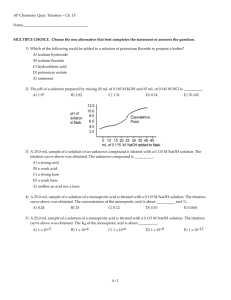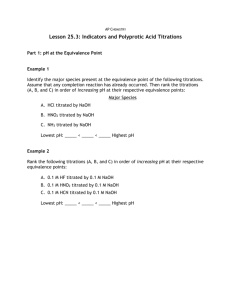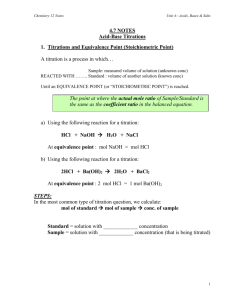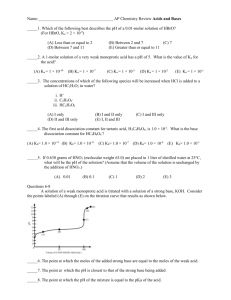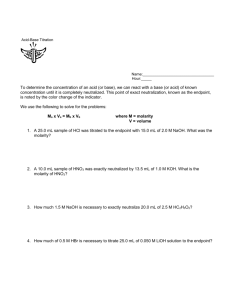File - wilson science WEBSITE
advertisement
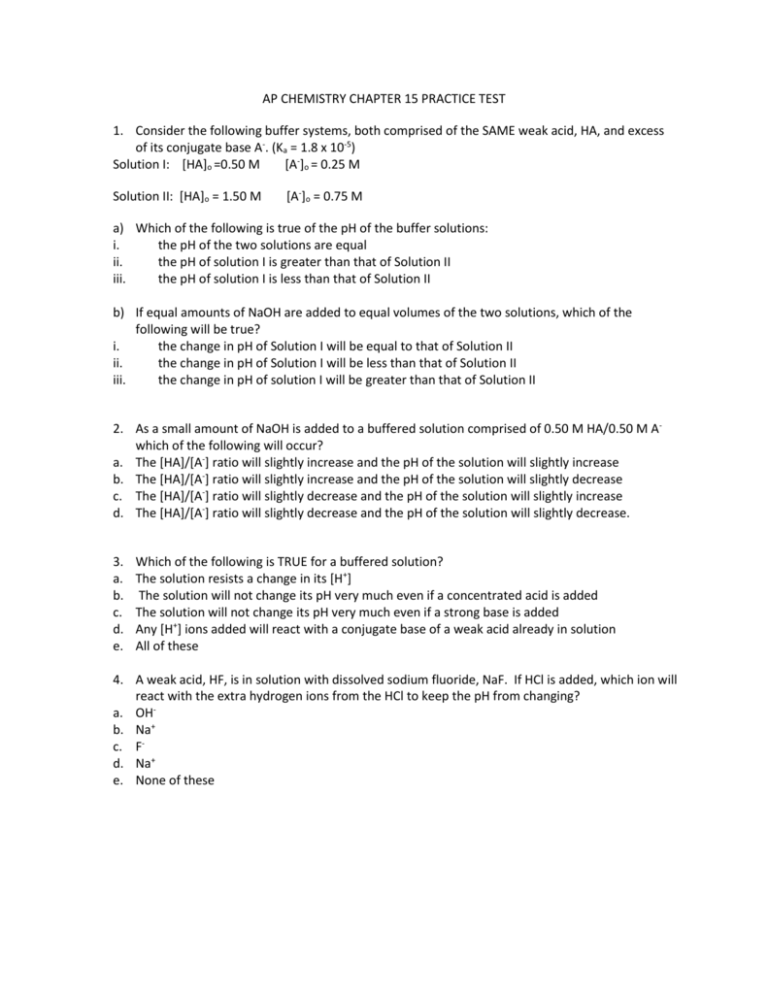
AP CHEMISTRY CHAPTER 15 PRACTICE TEST 1. Consider the following buffer systems, both comprised of the SAME weak acid, HA, and excess of its conjugate base A-. (Ka = 1.8 x 10-5) Solution I: [HA]o =0.50 M [A-]o = 0.25 M Solution II: [HA]o = 1.50 M [A-]o = 0.75 M a) Which of the following is true of the pH of the buffer solutions: i. the pH of the two solutions are equal ii. the pH of solution I is greater than that of Solution II iii. the pH of solution I is less than that of Solution II b) If equal amounts of NaOH are added to equal volumes of the two solutions, which of the following will be true? i. the change in pH of Solution I will be equal to that of Solution II ii. the change in pH of Solution I will be less than that of Solution II iii. the change in pH of solution I will be greater than that of Solution II 2. As a small amount of NaOH is added to a buffered solution comprised of 0.50 M HA/0.50 M Awhich of the following will occur? a. The [HA]/[A-] ratio will slightly increase and the pH of the solution will slightly increase b. The [HA]/[A-] ratio will slightly increase and the pH of the solution will slightly decrease c. The [HA]/[A-] ratio will slightly decrease and the pH of the solution will slightly increase d. The [HA]/[A-] ratio will slightly decrease and the pH of the solution will slightly decrease. 3. a. b. c. d. e. Which of the following is TRUE for a buffered solution? The solution resists a change in its [H+] The solution will not change its pH very much even if a concentrated acid is added The solution will not change its pH very much even if a strong base is added Any [H+] ions added will react with a conjugate base of a weak acid already in solution All of these 4. A weak acid, HF, is in solution with dissolved sodium fluoride, NaF. If HCl is added, which ion will react with the extra hydrogen ions from the HCl to keep the pH from changing? a. OHb. Na+ c. Fd. Na+ e. None of these 5. a. b. c. d. e. A buffered solution contains HC2H3O2. It also contains NaCl(aq) HC2H3O2(aq) NaC2H3O2(aq) KOH(aq) NaOH(aq) 6. For ammonia, Kb is 1.8 x 10-5. To make a buffered solution of pH 10.0, the ratio of NH4+ to NH3 must be: a. 1.8 to 1 b. 1 to 1.8 c. 0.18 to 1 d. 1 to 0.18 e. none of these Titration I: An aqueous solution of HIO2 is titrated with an aqueous solution of NaOH Titration II: An aqueous solution of HClO4 is titrated with an aqueous solution of KOH Titration III: An aqueous solution of NH3 is titrated with an aqueous solution of HCl 7. Write net ionic equations for each titration listed above 8. Which titration will have a pH of 7 at the equivalence point? 9. Which titration will have a pH less than 7 at the equivalence point? 10. Which titration will have a pH greater than 7 at the equivalence point? A 35.00 mL sample of a 0.250 M aqueous solution of a weak acid, HA, is titrated with 0.175 M aqueous solution of NaOH. Ka for the weak acid is 6.2 x 10-5. 11. Find the pH in the titration after the addition of 15.00 mL of the NaOH. 12. Use reaction stoichiometry to find the number of mL of NaOH needed to reach the equivalence point. 13. Find the pH of the solution at the equivalence point. 14. How many mL of base is needed to be added to reach the ½ way point? A 25.00 mL solution of a 0.100 M solution of weak base (B) is titrated with a 0.200 M solution of HCl. 15. The pH of the solution at the halfway point is 5.95. Find the Kb of the weak base 16. Find the initial pH of the solution of weak base (before any HCl is added) ANSWERS: 1. a. i. b. iii. 2. c 3. e 4. c 5. c 6. c 7. HIO2 + OH- → H2O + IO2H+ + OH- → H2O NH3 + H+ → NH4+ 8. II 9. III 10. I 11. pH = 3.84 12. 50.0 mL 13. pH = 8.608 14. 25.0 mL 15. Kb = 9.1 x 10-9 16. pH = 9.48

